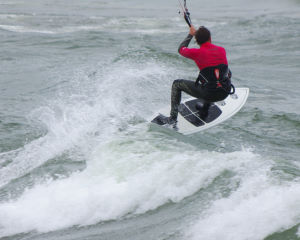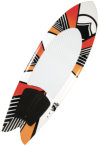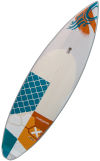Kitesurfboards vs. Surfboards for Kite Surfing
Kitesurfboards vs. Surfboards for Kite Surfing
by Tucker VanTol
 Kitesurfing is becoming vastly popular in the world of kiteboarding. Using your kite to ride waves is no new idea, but there are a growing number of riders who are focusing on this style of riding. Many riders are choosing to ride strapless boards not unlike a normal surfboard. There are a few distinct differences between kitesurfboards, hand-made surfboards, and production surfboards that make them unique.
Kitesurfing is becoming vastly popular in the world of kiteboarding. Using your kite to ride waves is no new idea, but there are a growing number of riders who are focusing on this style of riding. Many riders are choosing to ride strapless boards not unlike a normal surfboard. There are a few distinct differences between kitesurfboards, hand-made surfboards, and production surfboards that make them unique.
The typical hand-made surfboard has either a PU or EPS foam core often stringered with a hardwood. PU or Polyurethane foam is a crispy, easy-to-shape foam that can be glassed with either Polyester resin or Epoxy. PU/Polyester construction has been frowned upon recently because of its carcinogens and environmental impact. It provides a light, responsive, and affordable board. EPS, or Expanded PolyStyrene, is made of air filled foam beads. This type of foam can consist of up to 92% air. EPS foam boards must be glassed and repaired with either Epoxy resin or Vinyl Ester resin. Polyester resin will eat EPS foam like acid due to its Methyl Ethyl Ketone Peroxide (MEKP) catalyst. EPS is more difficult and expensive to work with, but is fast becoming the preferred method of board building. Surfboarder/Kiteboarder favorite shaper William "Stretch" Riedel has been using EPS epoxy construction for over 30 years.
 The glassing schedule on this style of board is designed for a lightweight, reflexive response, and is easily repairable. While these surfboards are the standard for performance riding while surfing, they are easily heel dented or broken under heavy stress. Many kitesurfers prefer the feel of this type of board, especially those who ride the wave without much kite power.
The glassing schedule on this style of board is designed for a lightweight, reflexive response, and is easily repairable. While these surfboards are the standard for performance riding while surfing, they are easily heel dented or broken under heavy stress. Many kitesurfers prefer the feel of this type of board, especially those who ride the wave without much kite power.
Many large board companies have turned to molded technology such as Surftech, Placibo, and Toughlight. These each have their own construction techniques but use basically an EPS foam core with either a wood or high density foam skin which is then fiberglass molded and painted with epoxy paint. This technology produces a very durable, stiff board that can range from easy to difficult to repair.
For a surfboard, these are slightly heavier and do not possess the reflex of a hand-shaped board. If you are looking for low maintenance, this is your ticket. These boards are not as susceptible to either heel dings or breaking, so you can come down on them harder without worry. If you are looking for a board to double as a surfboard and kitesurfboard then this could be your answer.
 Molded construction kitesurfboards are virtually the same construction technique mentioned above, with the addition of foot patches for extra durability on hard landings. Many also feature foot strap inserts.
Molded construction kitesurfboards are virtually the same construction technique mentioned above, with the addition of foot patches for extra durability on hard landings. Many also feature foot strap inserts.
Kitesurfboards tend to be around 1/2" thinner and 1-2" narrower than your traditional shortboard. This is because the power of the kite allows you to plane much easier than the power of a wave alone. Most kitesurfboards on the market are going to be very difficult for an average surfer to use as a surfboard. Some good examples of these are the Cabrinha Skillit and Cabrinha Subwoofer (new for 2013).
Kitesurfboard Shapes
Any rider's board shape preference is a result of conditions, riding style, wave type, and personal feel. There are however some general ideas that are universal in board preference:
 - More kite power will require a smaller board with thin rails.
- More kite power will require a smaller board with thin rails.
- Less kite power will require a larger board with more volume, similar to a traditional shortboard surfboard.
- The narrower the tail, the more leverage you will have on the board.
- Wider tails will catch more wave power and allow you to ride with less power.
- Round or thumb tail boards provide a smooth, predictable turn and hold well in steep waves.
- Square tails provide a lively feel that break loose easier when you want to. They also catch wave power more easily.
- Fish tails allow a controlled water release that provides a loose feel and can be faster in some circumstances.
 - If you like to ride powered in waves and possibly with straps a good choice would be the Cabrinha Trigger.
- If you like to ride powered in waves and possibly with straps a good choice would be the Cabrinha Trigger.
- If you like to ride with little power in the kite, almost as if you are surfing, try the larger Cabrinha Skillet sizes or a Boombox.
- If you are just getting into riding a surfboard, check out the Liquid Force Kitefish. It is a great way to hone your skills without breaking the bank. They work great in small waves and as a lightwind cruiser.
